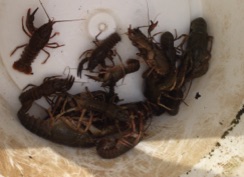

Invertebrate sampling
The invertebrate community forms an important component of aquatic ecosystems. Larger invertebrates are consumers of zooplankton (water fleas) as well as performing useful function as detritivores. They are in affect, both predators and prey. Water quality can be assessed by their presence, using community composition and species density within a waterbody. This is then applied to various biological metrics such as BMWP or ASPT. Invertebrates are a useful predictor of fish activity and the composition of the fish assemblage.
Macro Invertebrate sampling
This covers the larger invertebrates and includes all species of crayfish. We are NE licensed native white clawed crayfish surveyors. We provide suitable survey and reporting services to those who's work may impact upon this habitat. We provide control of non native crayfish and help contain spread of non natives through surveying and trapping, first class biological control practices and sound advice. Our staff are fully trained in biosecurity and non native species control, all having completed the Invasive Non Native Species Secretariat modules.
Invertebrate assemblage composition can be used as an indicator of pollution, particularly chronic pollution events, whereby lower scoring taxa may remain present but with an absence of the higher scoring ones. Lower scoring taxa are sometimes associated with a tolerance of poorer water quality condition and some are quite pollution tolerant. Invertebrates form a key element in the food sources of fishes. Many terrestrial invertebrates start out life under the water, before completing their life cycle above the surface.
Our laboratory undertakes species identification and density estimates and employs a variety of suitable industry standard metrics such as BMWP and ASPT scores etc for inclusion into reports, depending upon the clients requirements.

